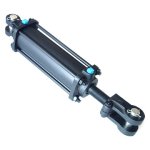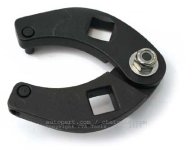One type of hydraulic cylinder uses a "tie rod" design. It has three or four long bolts (tie rods) running the length of the cylinder (on the outside of the cylinder where they are plainly visible) holding end-plates onto the cylinder.

It's pretty obvious how to open those, so I'm guessing your cylinder has a "gland nut" (keep your mind out of the gutter!) on the end that the rod (I said, keep your mind out of the gutter) extends from. The gland nut has two holes in it. A special wrench spans around the rod and has pins that fit into those holes. I found one for sale in a local business that caters to industrial folks but sells to individuals too. I just now found one on the net for $16.22 + shipping, pictured below. The website is (as of 08/08/2007)
Auto Parts and Automotive Tools

Note the square hole for inserting a ratchet or breaker bar.
Installing the seal kit is pretty straight forward, but first check the cylinder walls and the rod for scoring/scratches. If either are damaged, the new seals will just get eaten up. You might be able to sand out minor scoring with emery cloth. But if you have deep scoring you'll have to replace them (or just buy a new cylinder). Remove the old seals and lay them out in order, then install the new ones in the same order.
Finally, after the repair, be sure to remove and clean your hydraulic fluid strainer. You may have to do that two or even three times (maybe 15 usage hours apart). When the seals failed, they may have contaminated the hydraulic fluid with very small bits and pieces of the seal, especially if the cylinder or rod were scored.
I ordered the seal kits I needed from the manufacturer of the cylinder because it was convenient, but you should be able to take the disassembled cylinder to a local place that sells seal kits and have them match it up. Check your yellow pages under hydraulics. Some NAPA shops do hydraulic work and sell hoses/fittings.




